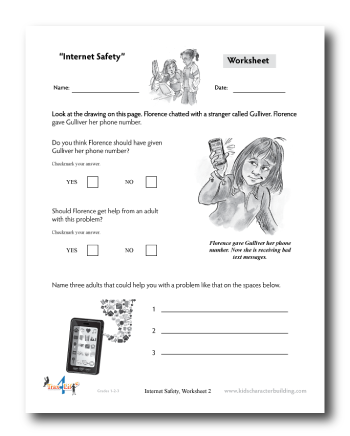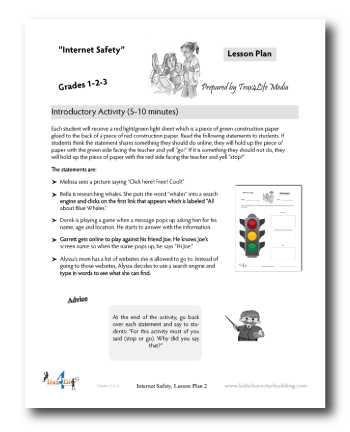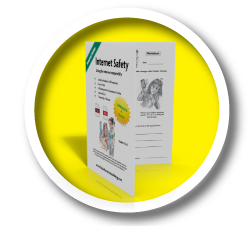
Introduction/Warm-Up (approximately 10 minutes):
In grades 1-3, students are just beginning to explore the Internet. They go online to play games, look at pictures or do small amounts of research for homework. However, flashing banner ads, Internet forms asking for information and links from strangers can quickly catch their eye. There are numerous predators online looking to prey on young children or expose them to information, pictures and videos they should not see. Students must be taught from an early age what to avoid online and why to avoid it so they grow up knowing how to avoid those predators and use the Internet safely.
Objectives
- Students will describe ways to be safe online.
- Students will recognize dangerous Internet behaviors.
- Students will explain what to do if they encounter negative information online.
Teacher Preparation
Teachers will familiarize themselves with the scenarios and examples used in the lesson and set up chart paper around the room to record student responses to questions during the lesson. Teacher will also print a copy of each handout for students and create a red light/green light sheet to use during the introductory activity.
Materials and Resources
- Red light/Green light construction paper sheet
- Internet Safety Pact (provided in lesson)
- Red light/Green light handout
- Chart paper and markers
Introductory Activity (5-10 minutes)
Each student will receive a red light/green light sheet which is a piece of green construction paper glued to the back of a piece of red construction paper. Read the following statements to students. If students think the statement shares something they should do online, they will hold up the piece of paper with the green side facing the teacher and yell “go!” If it is something they should not do, they will hold up the piece of paper with the red side facing the teacher and yell “stop!”
The statements are:
- →Melissa sees a picture saying “Click here! Free! Cool!”
- →Bella is researching whales. She puts the word “whales” into a search engine and clicks on the first link that appears which is labeled “All about Blue Whales.”
- →Derek is playing a game when a message pops up asking him for his name, age and location. He starts to answer with the information.
- →Garrett gets online to play against his friend Joe. He knows Joe’s screen name so when the name pops up, he says “Hi Joe.”
- →Alyssa’s mom has a list of websites she is allowed to go to. Instead of going to those websites, Alyssa decides to use a search engine and type in words to see what she can find.

- At the end of the activity, go back over each statement and say to students: “For this activity most of you said (stop or go). Why did you say that?”
Main Lesson (20-30 minutes)

Explain to students that people from all over the world can use the Internet. This includes good people and bad people. To help students stay safe from the bad people, teachers and parents create rules that kids should follow when they are online.
Ask students to brainstorm some of the rules for using the Internet that they have been given before and write them on a piece of chart paper.
Tell students you are going to give them a list of rules to help them use the Internet safely.
Start by asking students the following question: What is a stranger? (Students may respond with “someone I do not know” or “someone I cannot see.”)
Ask students what they do if a stranger tries to talk to them on the street or at a store. (Students may respond with tell a parent, walk away, ignore the stranger, etc.)
Tell students that if a stranger tries to talk to them online, they should do the same thing. On a large piece of chart paper at the front of the room, write the following two rules:
- Do not talk to strangers online.
- Do not give out your name, age, address or other info online.
Ask students to share what websites the like to go to online and what they do on those websites. Once students have shared that information ask them: how do you know those websites are safe? (Students may respond with a parent or teacher said it was safe, it has things kids like, they go there all the time, etc.)
Explain to students that while the websites they go to are safe, not every place they go to on the Internet is safe. They should stick to the places that parents and teachers know are safe instead of wandering around. Write the following rules on the same piece of chart paper as the rules above:
- Do not click any links unless an adult says it is okay.
- Do not click on any ads or flashing pictures.
- Do not use the Internet when an adult is not nearby .

Tell students that if they follow those rules, they will be safe online.
Ask students if they have ever broken the rules or caught a friend breaking the rules. If/when they say “yes,” ask them what they do when that happens (Students may respond with tell a parent or teacher, tell the friend to stop, etc.).
Ask students what Sam did when he caught Florence looking at bad Internet sites and chatting with a stranger named Gulliver.
Make a chart to hang in the classroom with things students can do if they break a rule or see a friend breaking a rule:
- Stop what you are doing
- Tell a friend to stop
- Tell a teacher or parent
Ask students to brainstorm some of the bad things that can happen if they do not take action when they see a friend breaking a rule or if they break a rule themselves. If students have trouble coming up with ideas, start by asking: What happened to Florence when she kept looking at bad websites?
Explain to students that not following the rules can lead to them seeing bad pictures and not being able to get images out of their heads, putting themselves in danger by talking to strangers and disappointing parents and teachers. However, if they follow the rules, they do not have to worry about any of that.
Print out the Internet safety pact and have all students sign it. Hang it up near the computer(s) so they can see it.
Assessment (10-20 minutes)
Have students fill out the “red light/green light” sheet listing things it is okay and not okay to do online. Review and discuss any issues that may arise with the student.

Teach about Internet Safety right now!
Grades 1-2-3

License
Family and/or One Classroom (Up to 35 Photocopies)
Two Classrooms (Up to 70 Photocopies) (+$3.00)
School Wide (Up to 350 Photocopies) (+$27.00)




